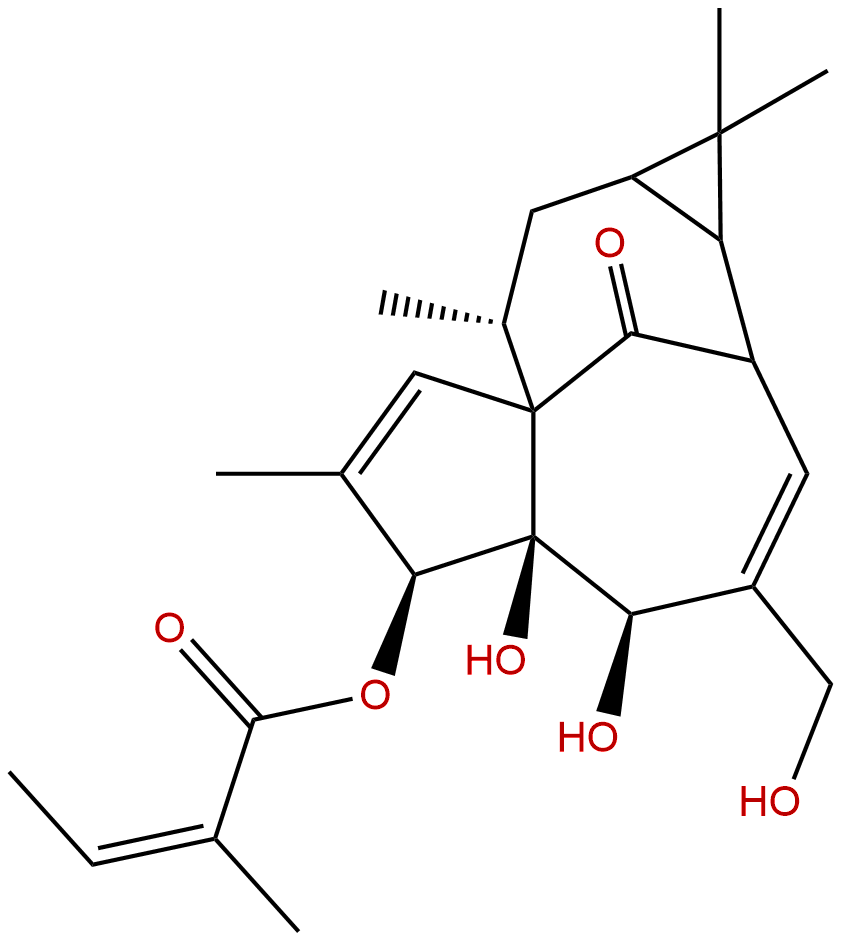
Ingenol MebutateCAS No.:75567-37-2
|
||||||||||
 |
|
|
||||||||

| Catalogue No.: | BP1635 |
| Formula: | C25H34O6 |
| Mol Weight: | 430.541 |
Product name: Ingenol Mebutate
Synonym name: 3-Angeloyl Ingenol; 3-Angelyl Ingenol; 3-Ingenyl Angelate; Ingenyl 3-Angelate; Ingenol 3-Angelate; PEP005
Catalogue No.: BP1635
Cas No.: 75567-37-2
Formula: C25H34O6
Mol Weight: 430.541
Botanical Source: Synthesis
Physical Description:
Type of Compound: Diterpenoids
Purity: 95%~99%
Analysis Method: HPLC-DAD or/and HPLC-ELSD
Identification Method: Mass, NMR
Packing: Brown vial or HDPE plastic bottle
The product could be supplied from milligrams to grams. Inquire for bulk scale.
We provide solution to improve the water-solubility of compounds, thereby facilitating the variety of activity tests and clinic uses.
For Reference Standard and R&D, Not for Human Use Directly.
Description:
Ingenol-3-angelate shows anticancer activity, and P-gp-mediated absorptive transport, dermal penetration, and vascular damage contribute to the anticancer activity of ingenol-3-angelate in vivo; it activates a broad range of PKC isoforms and induces apoptosis in acute myeloid leukemia cells by activating the PKC isoform PKCdelta. Ingenol-3-angelate suppresses HIV infection of primary CD4+ T cells through down-modulation of cell surface expression of HIV co-receptors. Ingenol-3-angelate emerges as a unique local chemotherapeutic immunostimulatory debulking agent that could be used in conjunction with immunotherapies to promote regression of metastases.
References:
PLoS Pathog. 2015 Jul 30;11(7):e1005066.
Synergistic Reactivation of Latent HIV Expression by Ingenol-3-Angelate, PEP005, Targeted NF-kB Signaling in Combination with JQ1 Induced p-TEFb Activation.
Although anti-retroviral therapy (ART) is highly effective in suppressing HIV replication, it fails to eradicate the virus from HIV-infected individuals. Stable latent HIV reservoirs are rapidly established early after HIV infection. Therefore, effective strategies for eradication of the HIV reservoirs are urgently needed.
METHODS AND RESULTS:
We report that Ingenol 3-Angelate (PEP005), the only active component in a previously FDA approved drug (PICATO) for the topical treatment of precancerous actinic keratosis, can effectively reactivate latent HIV in vitro and ex vivo with relatively low cellular toxicity. Biochemical analysis showed that PEP005 reactivated latent HIV through the induction of the pS643/S676-PKCδ/θ-IκBα/ε-NF-κB signaling pathway. Importantly, PEP005 alone was sufficient to induce expression of fully elongated and processed HIV RNAs in primary CD4+ T cells from HIV infected individuals receiving suppressive ART. Furthermore, PEP005 and the P-TEFb agonist, JQ1, exhibited synergism in reactivation of latent HIV with a combined effect that is 7.5-fold higher than the effect of PEP005 alone. Conversely, PEP005 suppressed HIV infection of primary CD4+ T cells through down-modulation of cell surface expression of HIV co-receptors.
CONCLUSIONS:
This anti-cancer compound is a potential candidate for advancing HIV eradication strategies.
Cancer Res. 2010 Jun 1;70(11):4509-19.
The skin cancer chemotherapeutic agent ingenol-3-angelate (PEP005) is a substrate for the epidermal multidrug transporter (ABCB1) and targets tumor vasculature.
Ingenol-3-angelate (Ing3A), extracted from Euphorbia peplus, is currently in clinical trials for eradicating basal cell carcinoma, actinic keratosis, and squamous cell carcinoma (SCC) in situ by topical application.
METHODS AND RESULTS:
Although structurally related to phorbol esters and a protein kinase C activator, topical Ing3A, but not phorbol 12-myristate 13-acetate (PMA), inhibited the growth of subcutaneous tumors derived from PAM212 (mouse SCC) and B16 (mouse melanoma). Ing3A and PMA both induced acute neutrophilic inflammation on mouse skin, but only Ing3A caused subcutaneous hemorrhage and vascular damage. Both Ing3A and PMA activated extracellular signal-regulated kinase 1/2 (ERK1/2) in epidermis, but Ing3A also activated ERK1/2 in skin dermal fibroblasts and endothelial cells. Pretreatment with topical cyclosporin A (CsA), verapamil, or XR9576, modulators of P-glycoprotein (P-gp), prevented Ing3A-induced hemorrhage but not neutrophil infiltration. CsA also impaired the anticancer activity of Ing3A, whereas the anti-inflammatory dexamethasone did not. Ing3A, but not PMA, blocked photoaffinity labeling of human P-gp with [(125)I]iodoaryazidoprazosin and inhibited P-gp-mediated drug resistance to HCT-15 cells. The intracellular levels of Ing3A were significantly lower in P-gp-expressing cells, and treatment with XR9576 increased the levels to those of cells that do not express P-gp, showing that Ing3A binds to and is transported by P-gp.
CONCLUSIONS:
Taken together, our results suggest that P-gp-mediated absorptive transport, dermal penetration, and vascular damage contribute to the anticancer activity of Ing3A in vivo.
Vaccine. 2009 May 18;27(23):3053-62.
Immunostimulatory cancer chemotherapy using local ingenol-3-angelate and synergy with immunotherapies.
Ingenol-3-angelate is a new local chemotherapeutic agent in clinical trails that induces primary necrosis of tumour cells and transient local inflammation.
METHODS AND RESULTS:
Here we show that cure of subcutaneous tumours with ingenol-3-angelate (PEP005) resulted in the generation of anti-cancer CD8 T cells that could regress metastases. Furthermore, PEP005-mediated cure synergized with several CD8 T cell-based immunotherapies to regress further distant metastases. PEP005 was shown to have adjuvant properties, being able to upregulate CD80 and CD86 expression on dendritic cells in vivo, and to promote CD8 T cell induction when co-delivered with a protein antigen.
CONCLUSIONS:
PEP005 thus emerges as a unique local chemotherapeutic immunostimulatory debulking agent that could be used in conjunction with immunotherapies to promote regression of metastases.
HPLC of Ingenol Mebutate
